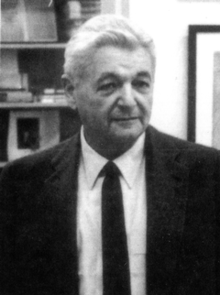Jerrold R. Zacharias
| Jerrold Reinach Zacharias | |
|---|---|
 |
|
| Born | January 23, 1905 Jacksonville, Florida |
| Died | July 16, 1986 (aged 81) |
| Nationality | American |
| Fields | Physics |
| Institutions | Massachusetts Institute of Technology |
| Alma mater | Columbia University |
| Thesis | The temperature dependence of Young's modulus for nickel (1934) |
| Doctoral advisor | Shirley Leon Quimby |
| Doctoral students | John G. King, Rainer Weiss |
| Notable awards | Oersted Medal (1961) |
Jerrold Reinach Zacharias (January 23, 1905 – July 16, 1986) was an American physicist and Institute Professor at the Massachusetts Institute of Technology, as well as an education reformer. His scientific work was in the area of nuclear physics.
Jerrold Zacharias was born on January 23, 1905 in Jacksonville, Florida.
Zacharias was involved in both the Radiation Laboratory at MIT and the Manhattan Project. He helped build the MIT physics department after the war, and was responsible for recruiting Bruno Rossi and Victor Weisskopf to the Institute. During the Cold War he was the head of a number of defense-related studies hosted at MIT (Project Hartwell, Project Charles, Project Lamp Light) and later he both founded and ran the Physical Science Study Committee, which was influential in changing physics education in the United States in the wake of Sputnik (1957).
Zacharias also developed the first practical version of the cesium-beam clock, often called an "atomic clock," which later became the internationally accepted standard for timekeeping.
In 1954 he testified at the security clearance hearing of J. Robert Oppenheimer, where he was accused of being part of a cabal known as "ZORC" (Zacharias, Oppenheimer, Rabi, Charles Lauritsen) that was attempting to do damage to U.S. national security. (On the contrary, Zacharias did much research to aid national defense.) He was later investigated by agents of Senator Joseph McCarthy. He did not cooperate with them and consequently there was fear that he might lose his job.
...
Wikipedia
